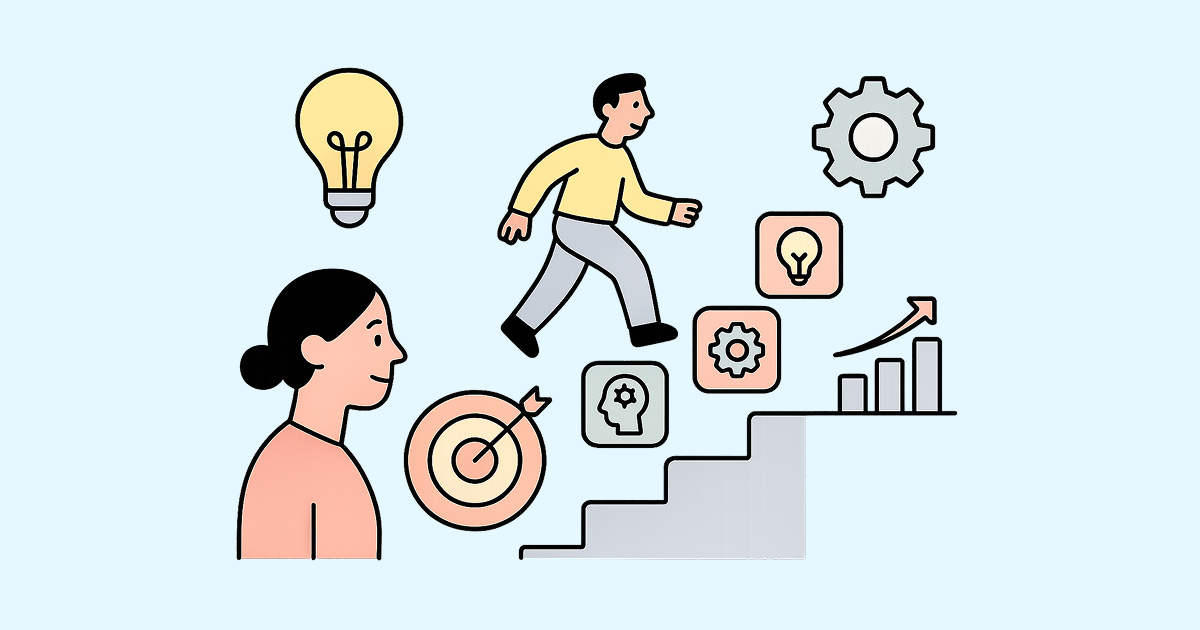Unlocking employee self-insight: The key to transforming learning, growth, and performance in 2025

Building a culture of self-insight is often the missing piece of the puzzle in most L&D strategies.
However, when you begin to ask yourself questions like:
- How do I future-proof your workforce?
- How do you make development plans that actually stick?
It’s clear that employees developing self-awareness is the answer.
And you’ll find out why in this article. We’ll cover:
- What self-insight is and why building it matters.
- The strategic business advantages of employee self-insight.
- How HR and L&D leaders can encourage self-insight at scale.
- How to put self-insight into action with practical examples
The following insights in this article have also been enriched by a wide range of thought leaders.
So, without further ado, let’s get into the full story.
What is self-insight and why does it matter in the workplace?
Employee self-insight is the capacity for an individual to understand their strengths, weaknesses, and how their emotions impact their day-to-day work.
Here are the core benefits:
Fosters a growth mindset
Building a culture of self-reflection in the workplace is critical for organisations to foster flexibility. Because guess what?
People change. Businesses change. Context changes.
Self-insight builds a growth mindset for employees, meaning that they act more proactively versus reactively, to certain situations. Rina Joosten-Rabou, CEO of Pera, joined an episode of the Moving Forward, sharing this same sentiment:
One of key things that we’ve found from research is that companies that transform and innovate faster, have employees that demonstrate competencies related to learning agility. These workforces can deal with lots of uncertainties that happen around them. They can demonstrate a degree of flexibility.
In case you’re interested, watch the full podcast episode with Rina, and Annabelle Vultee, CEO of GoodHabitz. They discussed the potential and power of AI in recruitment, retention, and development.
Crucial for personal and career development
Furthermore, personal development and self-insight work strongly when placed together. It provides a powerful avenue to put employees in the driver’s seat of their own career development. And this culture of autonomy fuels ownership and growth, leading to a culture of self- directed learning.
And for the younger workforces, this has become a critical requirement, when on the hunt for a role. Annabelle shared why:
Let’s get things straight. Gen-Z do job-hop more than previous generations. But don’t be too quick to judge.
She added that this commonly known term as ‘lily padding’ is down to the fact that:
Young workers are building dynamic portfolio careers at speed, that showcase skills earned rather than time served. They’re moving on when workplaces no longer service them for growth. They’re choosing personal development and fulfilment over loyalty. Change over comfort.
Read her LinkedIn post to find out more.
Job Toebosch, GoodHabitz’s Head of Tests and Insights, also shared his two cents:
Once an employee understands what their strengths and weaknesses are, or what their personal preferences are, they can subsequently determine what the best next step in their personal development journey should look like.
Job joined the Moving Forward podcast to discuss all-things related to the topic of self-insight. Tune in below.
The business case: Why employee self-insight is key to growth
Now we’ve set the scene, let’s dive into the business advantages of self-insight.
Impact on costs
L&D and HR leaders are constantly under pressure to prove the ROI of learning initiatives or strategies.
But self-insight is incredibly valuable in mitigating this. Job shared why:
Typically, what you’ll see is that learning opportunities are dependent on where the employee sits within an organisation. For example, someone very high up in the C-Suite might receive one-to-one coaching, whereas others might have access to a select few courses.
But here’s the problem: the higher up you go, the more expensive the offering becomes. And what’s why accessibility to learning becomes a barrier across the company.On the contrary, with self-insight, you’re giving everyone the possibility to learn about themselves, so they can craft their jobs and learning paths better.
The bottom line? Self-insight provides a non-hierarchical, cost-friendly form of learning and development.
Impact on employee engagement
The moment employees feel as though they’ve reached a ceiling, regarding opportunities for growth, their engagement dwindles.
Self-insight counteracts this, because employees feel motivated to work on themselves. This leads to productive actions and successes, which in turn increases engagement and workplace happiness.
Impact on workforce retention
Building self-insight creates an environment whereby employees feel empowered to understand why their character traits matter – both in professional and personal realms of life.
There’s an awareness that their company believes in a journey of self-discovery, which creates a sense of security. Therefore, workers feel less inclined to move roles.
And there’s data to back it up. As we’ve already explored, there is a strong link between self-insight and development; LinkedIn cited that 94% of employees stay longer in companies that have a vested interest in professional development.
Impact on leadership
Employee self-insight helps leaders align learning with real needs.
And this is crucial – now, more than ever before. Again, Annabelle explained why in the podcast episode:
And let’s not forget the impact on leaders, when they practice self-awareness themselves. Leaders with self-insight build inclusive cultures; embracing strengths and openly work on weaknesses demonstrates courage to the rest of the team(s).
Hanan Challouki, Inclusive Strategist and Communication Expert, explained why:
One of the most courageous things that an inclusive leader can do is admit that they don’t have all the answers. They say, ‘I don’t have an answer to that, but let me check my research, and I’ll get back to you’.
Building self-insight: How HR and L&D can enable it
Here are some strategic tips, that HR and L&D leaders can leverage, to enable self-reflection in the workplace:
Assessments
To encourage self-reflection, HR can integrate employee self-insight exercises. And an example of this are assessments.
- How do you work in a team?
- How do you respond to feedback?
- Are you a leader?
These are the types of questions you might indicatively get answers to during the interview process.
But if you leverage assessments and questionnaires right from the start of an employee’s career journey, you’re in a better position to lay the foundations for their development.
Job explained why:
Using self-assessments during onboarding means that you’re encouraging people to look deeper into themselves, from the start. There’s an expectation that’s set, which is that doing good work doesn’t just come down to whether you’re doing the right things. It’s also understanding who you are as a person, and whether you’re able to collaborate, innovate – human skills that accompany pretty much every role today.
360 Feedback loops
Self-insight doesn’t mean that HR and L&D need to take a step back. It's important to foster a culture of feedback to regularly encourage employees to act on their improvement areas.
Alix Jacobson, Former VP OF HR EMEA at Netflix, shared:
Feedback can be reframed as a gift – think of it as a show of trust, and a way to grow.
From self-insight to action: Linking awareness to development plans
Employee self-insight can translate into career growth.
Turn moments of reflection regarding strengths and weaknesses, into measurable goals. When it comes to performance or career reviews, look beyond whether someone has hit their goals or targets.
How can that employee be a better version of themselves? What do they want to work on, and how can managers support their goals?
Conclusion: Implementing a culture of self-insight
As we wrap up this article, let’s recap the key takeaways:
- Employee self-insight is the hidden driver of effective development and future-ready skills.
- Building a culture of self-awareness in the workplace, means that you can encourage autonomy. This, in turn, can have a positive impact on employee engagement and overall satisfaction.
- For the business, a culture of self-insight holds positive benefits, such as lower turnover, higher retention, and productivity.
- HR and L&D leaders can leverage practices such as self-assessments and career conversations, to foster and communicate the importance of self-insight.



